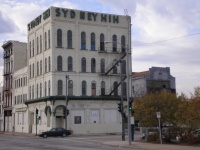The Abuse of Historic Preservation

Sydney Hih
Saving and restoring historic buildings is vital to any city. The mixture of styles, ages, heights, and character helps to create an interesting vibrant urban environment. Further, it is useful to have a mix of buildings with differing ages, because this allows for a variety of rental prices which allows new businesses to grow in old buildings. Unfortunately, these goals and ideals are far too often not why historic designation of buildings is implemented in Milwaukee. More often not our historic preservation laws are utilized for anti-development purposes, ensuring the status quo instead of pro-preservation and the redevelopment of existing buildings.
On Downer Avenue residents and New Land Enterprises bickered over if a surface parking lot could be developed or not, because it abutted a historic district. Along Prospect Avenue residents of 1522 On the Lake attempted to stop the building of Transera, by arguing it was on the same property as the Goll Mansion and therefore it couldn’t be developed as a high-rise. In both cases some level of actual restoration of neighboring buildings was part of the proposal, but these goals were not given much weight by those in opposition to the projects. In both cases the historic preservation laws were twisted in an attempt to preserve the status quo, and in the case of the Transera project to preserve a view, not to preserve any historic buildings.
All of these projects have one thing in common, the majority of the opposition wasn’t really about historic preservation. The process shouldn’t be utilized to protect a view, keep low-income residents out, or stop the construction of a new building in the neighborhood. It should be used to save historic structures, and encourage their adaptive re-use. If historic preservation is worthwhile and to be valued, then the process shouldn’t be tainted. This abuse must stop.



















It just never seems to end, does it? You think once you get a building saved you’ve won, but there’s always more layers of backwardness to deal with. Here, we’ve lost some historically significant buildings in various neighborhoods in the last year. People were surprised since they were on the National Register of Historic Places, but guess what? It’s absolutely worthless. If it’s not on the local register also, there’s nothing to stop demolition. In the place of some of these buildings now sit grass or parking lots. While that NIMBYism for stopping development from occurring is bad, it could be worse.
Looking at streetview I already see a tall condo tower, so now I understand the problem is not that the rest of the street consists of buildings only a few stories high, but that the residents of an already existing tall condo building don’t want another one in their way. I thought opposition was from residents in shorter buildings nearby.
I have always loved the Sydney HIH building- especially when it was a rainbow of color. It is just always delighted me.
I don’t know if you saw my post http://theriverotter.blogspot.com/2009/07/just-some-architecture-that-i-love.html about the different buildings on the St. Mary’s Milwaukee campus. The juxtaposition of differing architecture on the campus reminded me of a website I recently discovered, the Recent Past Preservation Network- buildings that are not old enough to qualify for historic preservation, but are at risk- http://www.recentpast.org/
Interesting thoughts on the NIMBY attitude and how it relates to architecture and preservation. Why are people so afraid? “Low income” doesn’t mean “bad people.”
“All of these projects have one thing in common, the majority of the opposition wasn’t really about historic preservation. The process shouldn’t be utilized to protect a view, keep low-income residents out, or stop the construction of a new building in the neighborhood. It should be used to save historic structures, and encourage their adaptive re-use. If historic preservation is worthwhile and to be valued, then the process shouldn’t be tainted. This abuse must stop.” Great quote.
This really makes a valid point. I think It’s real easy to see why we need to preserve historical structures. But having motives to save a structure, or in the Downer ave. case save a surface parking lot next to structures, to benefit yourself instead of the historical buildings is just wrong. However, this seemingly simple problem isn’t so simple to solve. How do we try not to kill development in areas where some local’s or others are thinking about themselves, yet still make sure we’re not discarding the voices of those who really wish to save these historical structures.
@Suzanne Yes, I am definitely a supporter of historic preservation. It is actually one of the features that makes Milwaukee a great city (often listed on historic travel spots), and I personally think the Sydney Hih actually deserves status. Not because of the building itself (though I like the corner structure), but because of the 70’s, yes 70’s, era artist collective, hippy, kinda thing. I actually got a card from a guy who has a great painting(er something), of when it had all the colors and I really want to buy one from him… As I said in the article my problem is that “historic preservation,” at least the way we implement it here in Milwaukee, has so little to do with historic preservation…. Hopefully we can eventually fix this…and yes I read your article, nice (I’m a RSS subscriber).
@Kevin, Thank you. I was hoping somebody would ask the important question as you did. Because, historic preservation matters, but how do we do it right. I hope to offer some ideas, though I still have to think on that a bit, but it is vitally important that we find a way to get this right. So that the process is used to encourage the saving of great buildings, not to stop growth in Milwaukee. Thanks again and suggestions and ideas are most definitely wanted.
“insuring the status quo” … should be “ensuring the status quo”
Sorry, have to nit pick on that one.
exuse me but that building is uglier than my butt. Please take it down a build a big and tall modern (glass and steel) building. It is tim to learn that we are in the 21st cenury and we need to go modern and contemporary. Make Milwaukee a Metropolitan city please. Thank you.
@Dave- “Not because of the building itself (though I like the corner structure), but because of the 70’s, yes 70’s, era artist collective, hippy, kinda thing.” It lasted past the ’70s LOL! I think it was a collective into the 90’s, of some sort anyway. And the Unicorn in the basement…
@Alex- you could, just, you know, move if you harbor such a strong opinion.
WRT this particular matter, which I know nothing about, _viewshed protection_ is a legitimate aspect of preservation, one that is too often ignored.
As a committed preservationist, albeit from another place, your story dismays me, because it reflects not just a problem with historic preservation but with the process and understanding of urban revitalization more generally.
Most neighborhood activism, whether it is about “historic preservation” or anything else, is about “preservation,” or keeping things the way they are or as best as can be expected.
As a movement in center cities, historic preservation came to the fore when most policies did not favor the preservation of historic building stock and saw the value of urban location only in land, which “needed” to be redeveloped in a manner favoring the car. This period is commonly called “urban renewal,” and the expansion of preservation activities was in response to this (and the construction of freeways in urban areas)–although the neighborhood preservation movement dates to the late 1920s in Charleston, SC, and to 1931, when the first designated neighborhood historic district was created there.
Most neighborhood activism, including preservation activities, came about when cities and neighborhoods were under threat, when cities were significantly losing population, along with deindustrialization and other trends which battered cities. In short, much neighborhood activism, including preservation, was about stabilization of neighborhoods in the face of disinvestment.
30-40 years later, many center cities–and at the very least, particular neighborhoods even within cities that otherwise have a weak residential real estate market overall–are in a different place, able to add population and businesses, as for a variety of reasons, trends favor urban living.
So infill development becomes a significant issue. How to do it in a way that is contextually sensitive, how to add residents (taxpayers) to communities that need more property and sales tax revenues, how to add people committed to and willing to help bring about neighborhood and city improvements?, etc.
But for the most part, the preservation movement (and neighborhood activists generally) hasn’t shifted to understand the change in material conditions. Most preservation advocates are older, and came to the fore during the long period of disinvestment. Now we need different approaches and for the most part, the movement hasn’t responded, and has difficulty recognizing that it needs to change.
I am pushing 50 myself, and my way of thinking on this is still seen as pretty radical by DC preservationists, and the younger people don’t quite understand the nuance of my argument, and don’t recognize the fact that in the long multi-decade period when the cities were dying, for the most part, preservationists stepped up and kept urban neighborhoods alive, which are now being enjoyed by new generations of homeowners attracted to the urban setting, but these same people benefiting from the fruits of the earlier labors fail to recognize the sacrifices and effort required to get to the place we are today.
You might be interested in a couple old blog entries of mine on this topic:
— http://urbanplacesandspaces.blogspot.com/2009/04/may-is-national-preservation-month.html
— http://urbanplacesandspaces.blogspot.com/2007/10/some-preservation-writing.html
@Alex A mix, yes a mix, of “glass and steel” buildings with older buildings is one thing that makes a city interesting.
@Suzanne yes, my bad In fact I think the building itself was multi-colored until the 2000s when Ruvin bought it. But I think you knew what I was trying to say right? That that building so called historic status, at least to me, has more to do with its recent history than its further history.
@Richard Welcome I’m a regular reader of your blog. To be clear the “viewshed” discussion is residents of a modern high-rise using historic preservation to protect their view of Lake Michigan, not of the historic structure.
Thanks! I appreciate the nit picking… and fixed.